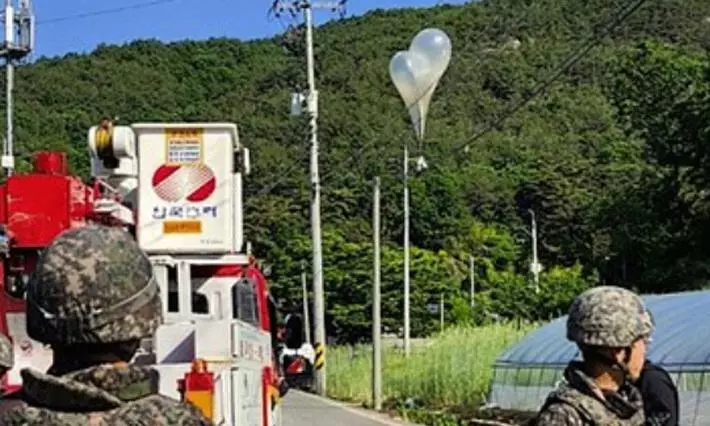Tensions Soar as North Korea's Balloon Warfare Escalates

In a disconcerting turn of events, North Korea has once again resorted to unconventional tactics in its ongoing propaganda war with South Korea, this time deploying a barrage of balloons laden with trash across the border. The recent incident, which saw at 3,500 balloons carrying a mix of filthy waste and trash drifting into South Korean territory, has prompted authorities to issue warnings urging residents to remain indoors and refrain from touching the hazardous debris.
South Korea warns its residents to not touch any of these balloons and to inform authorities if they come in contact.
Picture Courtesy : X
South Korea's military, while cautioning the public against any interaction with the white balloons and the plastic bags attached to them, has launched an investigation into the matter. The balloons, discovered in eight out of nine provinces in South Korea, are currently undergoing analysis as tensions simmer between the neighboring nations.
The use of balloons as a tool for propaganda dissemination is not new to the Korean Peninsula. Since the Korean War in the 1950s, both North and South Korea have employed this method to convey messages across the heavily fortified border. However, the recent escalation marks a disturbing trend, with North Korea resorting to the reckless scattering of trash and waste, endangering the environment and public safety.
The timing of this provocative act is particularly noteworthy, coming on the heels of North Korea's threats to retaliate against what it perceives as provocations from activists in the South. Just days prior, North Korean officials had issued warnings of impending retaliation, vowing to inundate South Korean territory with mounds of wastepaper and filth.
The response from South Korean authorities has been swift and unequivocal. Condemning the act as a clear violation of international law, South Korea's military has held North Korea accountable for the safety risks posed by the balloons. With reports indicating that some of the balloons may have carried hazardous substances, including feces, the seriousness of the situation cannot be overstated.
Picture Courtesy :X
Amidst the geopolitical tensions, the use of balloons as a means of propaganda dissemination raises questions about the efficacy of such tactics in the modern age. While activists on both sides have utilized balloons to convey messages ranging from anti-regime propaganda to humanitarian aid, the recent escalation underscores the potential dangers associated with these airborne campaigns.
In addition to the environmental and safety concerns, the balloon warfare also highlights broader issues surrounding freedom of speech and human rights. South Korea's parliament's decision to criminalize the launch of anti-Pyongyang leaflets in December 2020 has sparked debate over the balance between national security concerns and fundamental rights.
Picture Courtesy : X
Meanwhile, the tit-for-tat exchanges between the two Koreas underscore the fragile nature of inter-Korean relations, with provocations often triggering escalations in tensions. The history of balloon launches, which have targeted not only political adversaries but also civilian populations, serves as a sobering reminder of the volatile dynamics at play on the Korean Peninsula.
As both sides grapple with the fallout from the recent balloon incident, there is a pressing need for dialogue and diplomacy to defuse tensions and prevent further escalations. In an era marked by geopolitical uncertainty and heightened rhetoric, the need for restraint and responsible conduct cannot be overstated.
Ultimately, the airborne provocations serve as a stark reminder of the enduring animosities and unresolved tensions that continue to define the Korean Peninsula. Until a lasting resolution is achieved, the specter of balloon warfare looms large, casting a shadow over prospects for peace and stability in the region.

